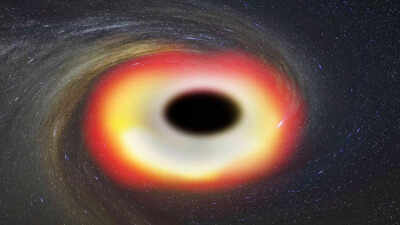Top Searches
- News
- India News
- India’s AstroSat witnesses black hole birth for the 500th time
India’s AstroSat witnesses black hole birth for the 500th time

India’s first dedicated multi wavelength space observatory, Astrosat, has detected the birth of a black hole for the 500th time, a key milestone that Indian scientists have called a “remarkable achievement”.
Elaborating on the research, Pune-based Inter-University Centre for Astronomy and Astrophysics ( IUCAA), in a recent statement, said, “One of the instruments in Astrosat is the Cadmium Zinc Telluride Imager (CZTI) — which has just witnessed the birth of a black hole for the five hundredth time.” “The wealth of data obtained by CZTI on Gamma Ray Bursts is making a big impact worldwide,” Prof Dipankar Bhattacharya of Ashoka University and IUCAA, who is the current principal investigator of CZTI, said.
AstroSat, launched by Isro in space in September 2015, is one of the most sensitive space telescopes in the world as it has five instruments that can simultaneously study the universe in ultraviolet, optical and X-ray radiation.
“The very first scientific result from AstroSat was the detection of GRB 151006A: just hours after the instrument was powered on after launch,” said Prof Varun Bhalerao, who leads the Gamma-Ray Bursts search effort.
Black holes are objects with a gravitational pull so strong that not even light can escape. They, therefore, generate a lot of curiosity among scientists across the world and are the focus of several international studies.
One way of forging black holes is the death of massive stars in “Gamma Ray Bursts ” (GRBs) – powerful explosions that are also called “mini big-bangs” as they send intense jets of light and high-energy radiation shooting across the universe. Another way to create GRBs is the collision of two neutron stars. Astronomers study Gamma-rays and X-rays from such bursts to understand the black hole formation.
AstroSat’s CZTI has been studying GRBs since it first opened its eyes 6.5 years ago. A unique aspect of CZTI is the ability to measure the “polarisation” of X-rays: an ability that is lacking in flagship missions like Nasa’s Neil Gehrels Swift Telescope or the US-Europe Fermi Space Telescope.
Tanmoy Chattopadhyay (Stanford University), who played a key role in these polarisation studies, says, “Polarisation tells us what is happening just outside the newly formed black hole. It is the most important measurement to distinguish between different theories of Gamma-Ray Bursts”. Numerous GRB studies from CZTI have been published in reputed journals worldwide.
Elaborating on the research, Pune-based Inter-University Centre for Astronomy and Astrophysics ( IUCAA), in a recent statement, said, “One of the instruments in Astrosat is the Cadmium Zinc Telluride Imager (CZTI) — which has just witnessed the birth of a black hole for the five hundredth time.” “The wealth of data obtained by CZTI on Gamma Ray Bursts is making a big impact worldwide,” Prof Dipankar Bhattacharya of Ashoka University and IUCAA, who is the current principal investigator of CZTI, said.
AstroSat, launched by Isro in space in September 2015, is one of the most sensitive space telescopes in the world as it has five instruments that can simultaneously study the universe in ultraviolet, optical and X-ray radiation.
“The very first scientific result from AstroSat was the detection of GRB 151006A: just hours after the instrument was powered on after launch,” said Prof Varun Bhalerao, who leads the Gamma-Ray Bursts search effort.
Black holes are objects with a gravitational pull so strong that not even light can escape. They, therefore, generate a lot of curiosity among scientists across the world and are the focus of several international studies.
One way of forging black holes is the death of massive stars in “Gamma Ray Bursts ” (GRBs) – powerful explosions that are also called “mini big-bangs” as they send intense jets of light and high-energy radiation shooting across the universe. Another way to create GRBs is the collision of two neutron stars. Astronomers study Gamma-rays and X-rays from such bursts to understand the black hole formation.
AstroSat’s CZTI has been studying GRBs since it first opened its eyes 6.5 years ago. A unique aspect of CZTI is the ability to measure the “polarisation” of X-rays: an ability that is lacking in flagship missions like Nasa’s Neil Gehrels Swift Telescope or the US-Europe Fermi Space Telescope.
Tanmoy Chattopadhyay (Stanford University), who played a key role in these polarisation studies, says, “Polarisation tells us what is happening just outside the newly formed black hole. It is the most important measurement to distinguish between different theories of Gamma-Ray Bursts”. Numerous GRB studies from CZTI have been published in reputed journals worldwide.
FOLLOW US ON SOCIAL MEDIA
FacebookTwitterInstagramKOO APPYOUTUBE
Looking for Something?

Start a Conversation
end of article

